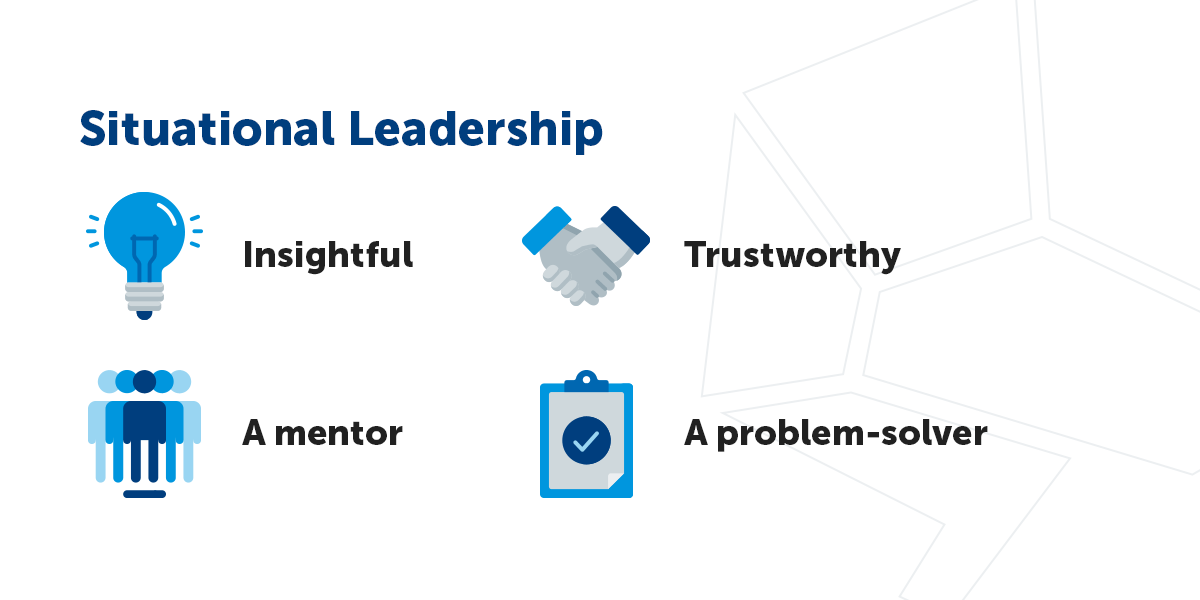
Types of Leadership Styles
As a leader, you want to find the best way to manage your team members to achieve the best results. Throughout the years, leaders have utilized different leadership styles to encourage their teams and meet their goals. These styles evolve as we always look for new and improved ways to help our companies or businesses grow.
Below, we'll explain the importance of knowing your leadership style, the different types of leadership styles and how you can adapt your style to fit unique circumstances, solve problems and encourage growth among each team member.
What Is a Leadership Style and Why Is It Important?
A leadership style describes how a leader behaves and what methods they use to encourage, direct and manage their team. A leadership style will also define strategies to achieve specific goals and implement these strategies. A successful leadership style will account for the expectations of shareholders and the welfare of the team.
Knowing how you lead will help you see how people are affected by your leadership style. You can also determine how your team members see you as a leader. With feedback, you can choose which leadership style is best for the situation and adapt, but knowing your leadership style beforehand can potentially remove the need for feedback. Knowing your leadership style will allow you to use and adjust characteristics from other styles when encountering a challenging situation.
Traditional Leadership Styles
Over the years, multiple leaderships styles have developed to provide direction and achieve goals. Each of these traditional leadership styles has its advantages and disadvantages. Below are some of the most common leadership styles:
1. Authoritarian Leadership
With an authoritarian leadership style, the leader can set specific expectations and define strict outcomes. Generally, one person is in charge of the whole group rather than delegating leadership roles to others. This type of leadership can be helpful when the leader has the most knowledge to achieve set goals. If the group is under a time constraint, having one leader can be efficient, but the team's creativity might be sacrificed since team input is restricted.
Other advantages of this style of leadership include:
- - An established hierarchy.
- - Dependable results.
- - Fewer mistakes.
- - Less time spent making decisions.
While the authoritarian leadership style can be beneficial in certain circumstances, it also has some disadvantages:
- - Reduces collaboration
- - Increases turnover rate among employees
- - Limits creativity
- - Can cause rebellion

2. Democratic Leadership
Democratic leadership works a lot like a democratic government. The whole team communicates their ideas and has a say on the direction of a project, but the leader will make the final decision. A democratic leadership style can be incredibly effective in many situations, especially since lower-level team members learn valuable skills they can utilize in future advanced positions. This style also closely resembles how decisions are often made in leadership settings, such as a company board meeting.
Some of the additional advantages of democratic leadership include:
- - Increased participation among team members.
- - The room for additional insights.
- - The ability to solve complex problems.
- - Strengthening the bond between team members and leadership.
- - Creating a clear vision for the future.
- - Increased commitment and job satisfaction.
There are many benefits to the democratic leadership style. However, before implementing it in the workplace, there are some disadvantages to be aware of before implementing it. Some of the disadvantages of democratic leadership include:
- - Possibility of resentment between team members as well as leaders.
- - Chance for procrastination.
- - Delays in projects and tasks because of large discussions.
- - Not guaranteeing the best possible solution.
- - Encouraging the idea that no one is responsible for a failure.
- - Creating uncertainty between team members and leadership.
While democratic leadership can be an effective way to solve problems in the workplace, it doesn't work in every situation. It requires skill and educational experience to pull off. The goal of democratic leadership is to gain insight from all team members. If some team members lack specific skills or knowledge, they likely won't be able to offer meaningful feedback or insight during a meeting. The effectiveness of this leadership style will depend upon the capabilities of your team members.
3. Transformational Leadership
As the name implies, a transformational leadership approach transforms or improves upon its goals. While each team member may have tasks to complete, a transformational leader will attempt to push each member beyond their comfort zone to achieve innovative results. As a transformation leader, you would serve as a role model to encourage team members to help achieve your visions. Some of the advantages of this leadership style include:
- - Reduced employee turnover rate.
- - Increased morale among team members.
- - Placing a high value on goals.
- - Not coercing team members to accomplish tasks.
- - A focus on creating positive relationships.
With the many advantages of the transformational leadership style, there are also some disadvantages, such as:
- - Possible deception towards team members.
- - Motivation having to be consistent.
- - Team members having to agree on tasks before they can begin.
- - Deviation from company regulations and standards.
4. Transactional Leadership
A transactional leadership approach occurs when a leader uses positive or negative reinforcement, such as rewards or punishments, to encourage team members to complete tasks. The leader will set a defined goal or task and establish incentives for team members who meet their goals. Rather than changing or transforming a company or organization, this leadership style focuses on following predetermined procedures or routines. The goal is to complete tasks efficiently by motivating employees through incentives. Some of the advantages of transactional leadership include:
- - An ability to create specific and achievable goals that team members can complete within an established time frame.
- - Increased productivity and motivation among team members.
- - Reducing confusion in the hierarchy.
- - Being simple to follow and implement.
- - The ability for employees to choose their incentives.
These benefits can create a work environment where goals are constantly accomplished, but there are a few disadvantages to consider before taking on this leadership style:
- - The opportunity for creativity or innovation is heavily limited.
- - Empathy is not a valued quality.
- - It creates more followers among team members than future leaders.
- - There is little focus on building positive relationships.
- - It is challenging to find incentives to fit all employee's needs.
- - There is a focus primarily on short-term goals rather than long-term goals.

5. Laissez-Faire Leadership
Laissez-faire is a French term that allows your team members to do what they want during work and trusts them to complete tasks that serve your vision. Essentially, this leadership style doesn't define any specific policies or deadlines for team members. Laissez-faire leadership trusts the employees to complete work, and leadership focuses more on running the business. The laissez-faire leadership style:
- - Encourages personal growth of team members.
- - Fosters an environment for learning and career development.
- - Allows for quick decision-making.
- - Promotes freedom to innovate and increase productivity.
While a lack of defined structure can work well for some team members, it's not a suitable approach for everyone. Some of the reasons you might not choose this leadership style for every team member include:
- - Lack of clarity about the requirements of the job or task.
- - Isolation from other team members and lack of collaboration.
- - The challenge to create meaningful bonds.
- - Difficulty maintaining accountability in leadership.
- - Low morale and a lack of encouragement among team members.
Laissez-faire leadership can work when you have complete trust in your team members to complete tasks. However, some individuals will need more guidance, which means that this leadership style won't work for everyone.
The same goes for each type of leadership style. No matter which style you choose, some team members will be receptive to it, while others may feel that they're not being heard or need more support than certain leadership styles can provide. That's why leaders need to adapt to individual circumstances and choose the leadership style that will work best at the moment.

Situational Leadership
While the above leadership styles can be helpful in certain circumstances, they won't work in every instance. Instead, you should consider using a situational leadership style, which allows you to adapt to unique situations and choose the leadership style that will work best.
Situational leadership will consider the abilities of each team member and how they can be applied in an individual situation. A situational leadership approach will encourage all team members to be flexible and adaptable. Using this leadership style, you'll shift your mindset from telling people what to do to asking them to complete specific tasks. First, you'll need to assess the skills of each team member and how confidently they can handle a situation.
All team members will have different skill levels and motivation for completing delegated tasks. If you use the same leadership style for each team member, you may only find success with some members rather than your whole team. Some team members will respond positively to your chosen leadership style, while others may find it more abrasive or underwhelming. Situational leadership allows you to adapt your leadership style to accommodate the unique circumstances of each team member, creating an adaptable and successful work environment.
To be a successful situational leader, you must be flexible to serve the needs of each team member best. You know best what your team members need, and adjusting your leadership style based on these needs is an essential skill for every leader. A situational leader should be:
- - Insightful: If you're using a situational leadership style, you need to be able to assess the needs of each of your team members in any given situation. You can determine if your team members are confident or insecure in handling tasks and if they'll need supplemental support.
- - Trustworthy: If your team members feel like they can trust you and communicate without fear of judgment or repercussions, they're more likely to flourish in the workplace. You can build trust between yourself and your team members by encouraging a positive connection and communicating openly with one another.
- A problem-solver: Being able to solve problems as they arise is one of the essential skills a situational leader should have. If you can solve problems and adapt your leadership style, you and your team will be more successful at achieving your goals.
- A mentor: A situational leader should be able to act as a mentor and guide their team members in the right direction. Encouragement and positive reinforcement can help give your team members direction and clarity in their work and help the whole team achieve their goals.
You can motivate your team members to achieve more at work with a situational leadership style. When you work with each team member and utilize their existing skill set, they'll improve their skills and help you accomplish your goals.
Our TAPs Model
The situational leadership style can help you adapt to different circumstances, but sometimes, it can be challenging to identify the exact situation that needs to be resolved. Using the Tell-Ask-Problem-Solution (TAPS) model, you can quickly identify a problem in the workplace and then choose the right leadership style to reach a solution.
With the TAPS model, you look for insight from employees to help understand the problem and find innovative solutions. First, you'll gather information from employees about the issue. They'll tell you the problem they're experiencing, and then you can ask questions to determine why this problem is occurring in the workplace and how it might be fixed. With this data, you can dive into solutions, remembering to consider employee insight.
You can help support employees generate insights by:
- - Encouraging them to take breaks between each meeting or as they complete tasks.
- - Allowing employees to have some downtime so their minds are sharp and open to new ideas.
- - Taking a break from decision-making to allow the brain to reset.
By taking these steps, employees can quickly identify insightful thoughts, no matter how small or insignificant they might seem at first. They'll develop a deeper understanding of some of the challenges they're experiencing in their work and find solutions to help them overcome specific obstacles. Asking "why" or "how" questions can also help employees reach new insights faster, which is ideal if you don't have time to spend with each of your team members.
Encouraging a two-way conversation between leadership and employees by asking questions and proposing solutions also helps for reflection and creates a sense of equity in the workplace. Rather than just checking in on employees as they complete tasks, the TAPS model allows for genuine insight to help you progress more quickly towards your goals.
Learn Professional Leadership Skills at NeuroLeadership Institute
If you're a leader in your field, whether a manager or coaching professional, NeuroLeadership Institute will help you learn professional coaching skills to bring your leadership to the next level. We created our science-backed coaching programs to help you understand how the brain works, so you can better lead each member of your team. We offer two different programs to help you develop your leadership skills.
Our Brain-Based Coaching (BBC) program was designed to help leaders encourage positive change in their environment by using neuroscience as the basis for the development of various leadership skills. Our second program is the CFN Certificate in the Foundations of NeuroLeadership, which helps leaders develop a deep understanding of neuroscience and how it can help them develop their skills. Learn more about our programs and how they can help by scheduling a discovery session today.

